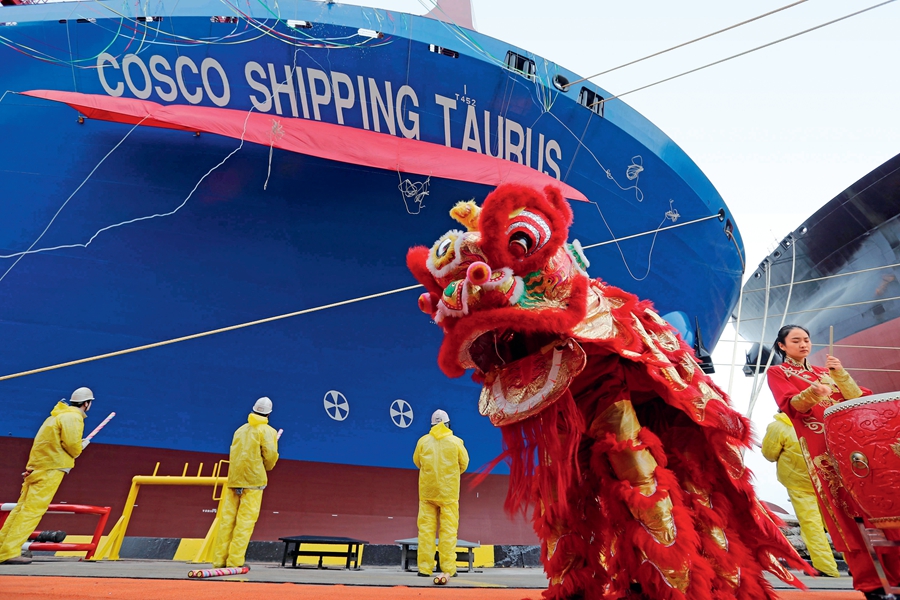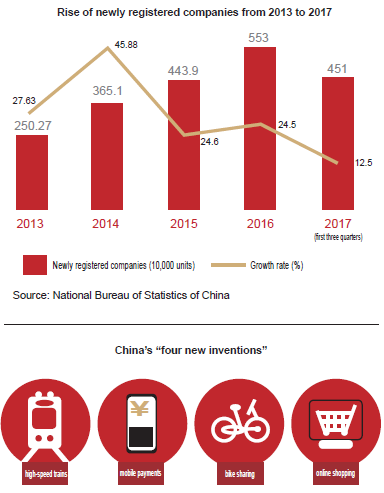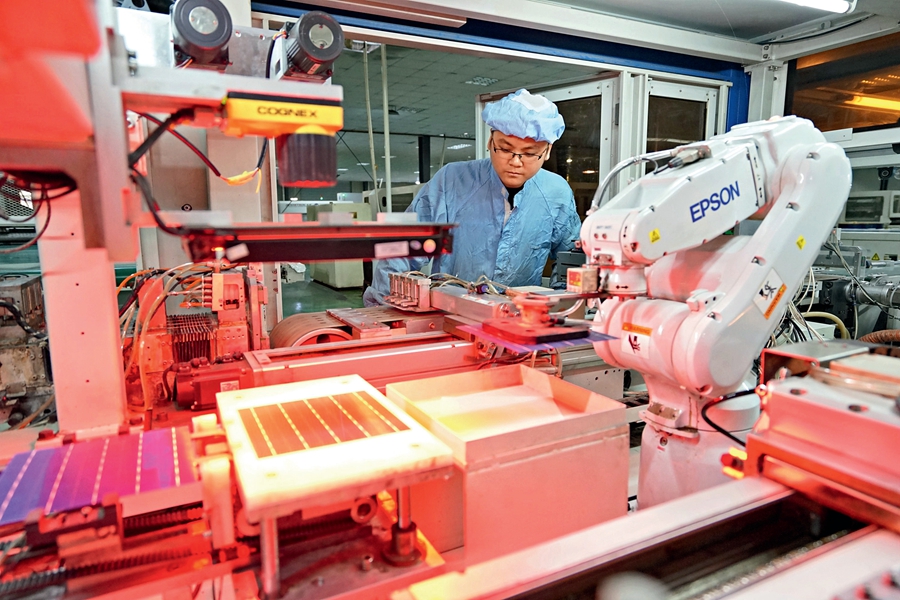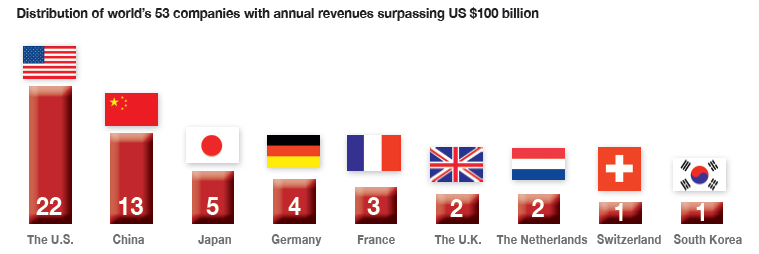By SHENG CHAOXUN
DRIVEN by the innovation-oriented overarching plan, Chinese society is vibrant and exhilarating – a profusion of start-ups emerged, fledging industries developed, and the industrial structure as well as quality and efficiency improved. From a holistic view, the economy is steering towards mid- and high-end levels of development.
Innovation Propels Development
Innovation is undoubtedly the major force driving the Chinese economy. In the last few years, a batch of high-tech outcomes were unveiled, marking symbolic breakthroughs in key fields such as manned space flights, lunar exploration, quantum communication, Five-hundred-meter Aperture Spherical Radio Telescope (FAST), manned submersible, and the world’s fastest supercomputer. In 2016, the number of patent applications surpassed 1.33 million, twice of that of 2012, winning China the pole position in the world for six consecutive years.
COSCO Shipping Taurus, the first Chinese-built 20,000 TEU vessel, launches on January 27, 2018.
Along with the laxity of China’s commercial registration institution and related management, innovative outcomes have been widely applied in businesses, which, in return, inspired entrepreneurship among scientists, college graduates, returned overseas personnel, and even migrant workers. In 2017, about 16,500 companies were established every day, which doubled 2012 numbers.
In such context, the new economy including new industries, new business, and new modes of business have emerged, which is best represented by the digital economy, network economy, platform economy, and sharing economy. On the other side, the online-offline infusion has been accelerated, trans-border e-commerce prospered, and the concept of smart homes prevailed. In a recent survey, high-speed trains, mobile payments, bike sharing, and online shopping were selected as China’s “four new inventions” in modern times.
According to the Global Innovation Index 2017, China moved to the 22nd slot, up from the 34th in 2012, leading the middle-income economies. Many international organizations, such as the World Bank, spoke highly of China’s economic restructure and innovation, commenting that the innovation-powered nation would be the driving force of the world.
Co-existence of Different Companies
In China, it is not abnormal to see the impact of disruptive innovations, represented by all kinds of “black technologies.” Quite a few companies provided constant, substantial input on innovation, based on their own experience. The innovation is diverse in all forms and sizes – big or small, revolutionary or progressive; and the way of turning ideas to reality shows more flexibility.
According to the nation’s overarching plan, strategic emerging industries and high-tech industries serve as the pillar of the innovation-driven development. Meanwhile, Internet Plus and Made in China 2025 were introduced to traditional manufacturers of the light industry, textiles, mines, iron and steel, petrochemicals, and agriculture and services, directing these industries into a more digital, network-driven, smart, and high-end development path.
By improving the digital infrastructure, China is able to develop next-generation telecommunication products and technologies, new businesses, and new modes, thus promoting the connection of the new and old industries and enhancing coordinated development between innovation and industries.
For now, the strategic emerging industries account for more than eight percent of China’s GDP, playing a leading role in industrial upgrading. In 2016, equipment manufacturing and high-tech manufacturing made up 32.9 percent and 12.4 percent of all industries, up 4.7 percent and three percent respectively from the 2012 levels. The market also saw a surge of new products like industrial robots, new energy autos, SUVs, and smart phones. The prevailing mobile Internet boosted e-commerce, which in 2016 reached RMB 26.1 trillion in business scale, 3.4 times over that of 2012. The so-called “happiness” industries, including tourism, culture, healthcare, and senior care industry, have developed fast, as products’ quality improved, quantity increased and consumption model more sustainable.
In a workshop of ChinaLand, a company engaged in photovoltaics in Hefei, Anhui Province.
Pro-innovation policies extended their presence from high-tech fields to the real economy, especially information, healthcare, energy, and green industries. The service and manufacturing industries have seen a coordinated development, with the service industry achieving rapid growth. For the first time, in 2015, the added value of the service industry accounted for half of the national economy, and the ratio rose to 51.6 percent in 2016. With regard to the contribution to economic growth, the service industry accounted for 44.9 percent in 2012, and surged to 58.2 percent in 2016.
Seizing the opportunities generated by the Belt and Road Initiative, China attaches great importance to innovation and international cooperation. On the one hand, it strives to facilitate transnational enterprises and prestigious research institutions to set up research and development (R&D) centers in China. On the other, domestic companies are encouraged to build global R&D systems by establishing research centers and bases for innovation abroad, which has steadily enhanced the country’s industrial competitiveness in the world. China’s economic indicators in certain aspects stand at the forefront of the world. For example, the output of major industrial products and global manufacturing competitiveness index have been ranked the highest in the world. According to the Global Competitiveness Report 2017-2018 released by World Economic Forum, China stood at number 27 in 2017, up two places compared to 2012. In addition, 115 Chinese companies hit the Fortune 500 list for 2017. The figure, increased from 79 in 2012, ranked second in the world. To date, the country boasts 13 companies whose annual revenues have exceeded US $100 billion, taking up nearly a quarter of the world’s figure.
Green and Inclusive Development
At the 19th National Congress of the Communist Party of China last October, building a beautiful China was established as a new goal for Chinese people. Enterprises will be further supported to make their development modes cleaner, safer, and more energy-saving. In the meantime, a green industry system featuring energy conservation, environmental protection, and resources recycling will be built.
As a new growth point, green development stimulates a rapid technological advancement in such fields as new energy automobiles and clean energy. New technologies are expected to play a bigger role in these areas, including high-efficiency solar thermal energy and photovoltaics, wind power, efficient energy storage techniques, distributed energy resources, among many others.
Administrators at all levels in China are embracing green development and the country is endeavoring to achieve a balance between economic and ecological progress. Today, considerable areas of green space can be seen in more cities, adding to the draw of cities vying to attract investment from high-end industries.
Innovation-driven development, instead of involving and benefiting merely a small number of people, has reached a wider public. The fruits are shared by innovators, manufacturers, and consumers of all kinds.
In addition, companies, regardless of their sizes, have much space to advance. Guided by the new vision of development, many large enterprises have rapidly grown into giants in certain fields. At the same time, start-ups are exponentially rising. Micro, small, and medium firms have significantly increased their investment in research and development. Besides, the number of “unicorn” companies are mushrooming. In 2016, one fourth of the world’s 200 unicorns that valued above US $1 billion were from China.
Nevertheless, more efforts need to be made to improve independent innovation, core technologies and key components development, human resources management, and brand building. Therefore, a national-level network for innovation should be constructed in order to pool resources to shore up weak links in the industry.
Endeavors should include making breakthroughs in key technologies, setting up a batch of alliances to promote industry innovation, launching projects to make the foundation of industry development more solid, and introducing measures to further improve the quality of Chinese products.
SHENG CHAOXUN has a PhD in economics and is deputy director and associate research fellow at the Research Department of Industrial Structure and Policy of Institute of Industrial and Technological Economics, Chinese Academy of Macroeconomic Research.



